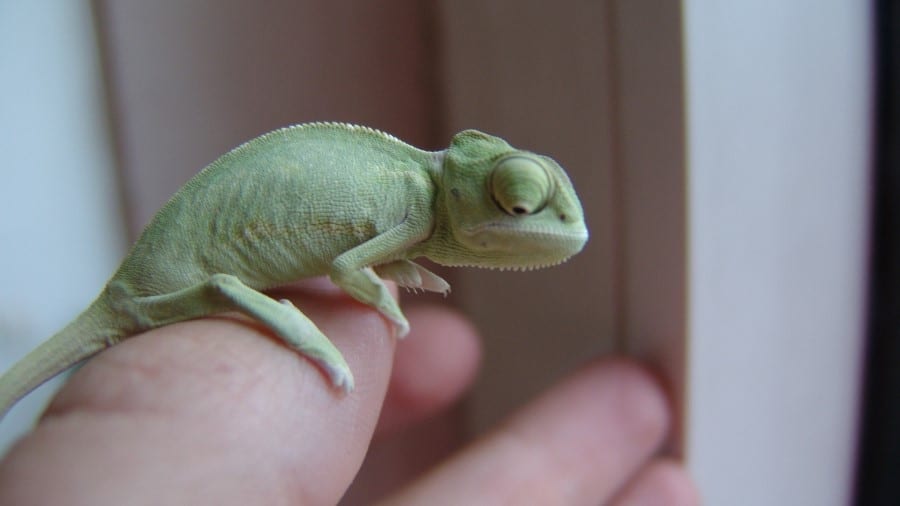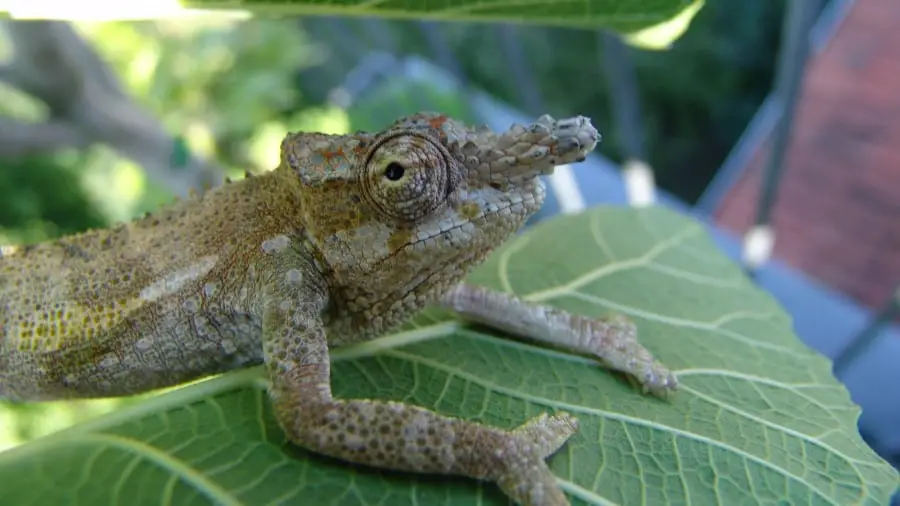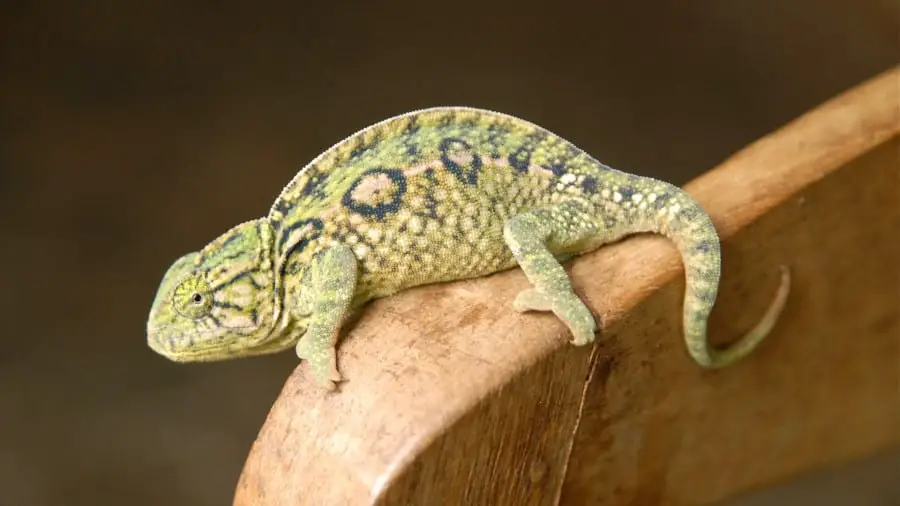
Like humans, chameleons vary in size and some will stay small no matter what. The difference here is that the largest and smallest chameleons have a huge discrepancy where the smallest can almost amount to nothing when compared to the largest.
The Parson’s chameleon is the largest chameleon known to man and they can grow up to 27 inches in length. The average length of a chameleon isn’t that far off as well, being around 15 to 20 inches in length.
Any chameleon below 10 inches is considered very small. Of course, baby chameleons will be significantly smaller than adult ones, but did you know that some chameleon species are smaller in adult form when compared to the babies of others?
Here, I will talk about some species of chameleons that stay small no matter which stages they are at… from baby to adult.
Why Do Some Chameleons Stay Small?
Chameleons vary in size according to species because of their genetic build-up. Some chameleons have genes that cause them to look like dwarves when compared to larger species of chameleons.
They will also differ in size because of their place of origin. It is generally believed that animals that hail from oxygen-rich areas will tend to be larger due to the abundant oxygen but many other factors will affect it too.
These factors include their way of survival, relative habitat, the relative size of surrounding animals and etc. There are just so many factors that it’s hard to pinpoint what exactly affects the size of a species of chameleon directly.
5 Species Of Chameleon That Stay Small (Under 10 Inches)
Here are some of the species of chameleon that stay under 10 inches. They will stay small no matter the stage they are in.
1. Senegal Chameleon

Full Grown Length (Head To Tail): 8 inches
Adult Weight: 32 grams
Lifespan: Up to 5 years
The Senegal chameleon is a species of chameleon that hails from the moist savannas of West Africa. Their technical name is called the Chamaeleo senegalensis and they are considered to be one of the most popular chameleons kept as pets despite their size.
They may be small, but they are just as beautiful as any other chameleon out there. The Senegal chameleons grow up to 8 inches in length with a lifespan of about 5 years but females who lay eggs more often might live significantly shorter lives.
They require high humidity levels and optimal lighting to thrive in a domestic environment. UVB lights are a must with heat lamps that can sustain at least 70°F peaking at 85°F for basking.
These chameleons can eat almost all live foods that normal chameleons eat except for the obviously larger ones.
2. Fischer Chameleon

Full Grown Length (Head To Tail): 9.5 inches
Adult Weight: 50 grams
Lifespan: Up to 4 years
The Fischer Chameleon is the largest chameleon on this list but still smaller than typical chameleons. Named the Bradypodion fischeri, they hail from the high mountains of Kenya and Tanzania in East Africa where rainfall is prominent but the sun isn’t that absent as well.
They are usually recognized by their two distinct horns in front of their face that almost resembles a triceratops. They can grow up to 9.5 inches in length with an average lifespan of about 3 to 4 years.
High levels of humidity are needed due to their place of origin to keep them healthily hydrated. The Fischer Chameleons thrive in temperatures of around 80°F with 85°F being their highest basking point.
UVB light is a must, just like any other chameleon. Food will not be a problem as they are the largest in this list of small chameleons.
3. Pygmy Chameleon

Full Grown Length (Head To Tail): 3.5 inches
Adult Weight: 20 grams
Lifespan: Up to 3 years
The Pygmy Chameleon is one of the smallest chameleons on this list that hails from many areas in Central Africa. They can be found in forests, thickets, savannas, but most of them are restricted to the highlands.
Pygmy chameleons are better to be taken care of by veteran chameleon owners due to their small size which makes them hard to take care of. They grow up to 3.5 inches in length as an adult and can live up to 3 years given the right conditions.
Humidity levels around 60% to 80% is more than sufficient to keep them hydrated. They like being in temperatures of around 65°F to 80°F with 70°F being the sweet spot for them as an average.
Unlike most chameleons, they don’t require gradient temperatures or supplemental UVB lights. This most likely has something to do with the fact that they live on the forest floors.
4. Carpet Chameleon

Full Grown Length (Head To Tail): 8 inches
Adult Weight: 200 grams
Lifespan: Up to 3 years
The Carpet Chameleon, also known as the jeweled chameleon, is one the heaviest chameleons relative to their size. Named Furcifer lateralis, they originate from the mixed woodlands of Madagascar.
They are highly sought out for their amazing coloration but they have more sensitivity hence easily stressed. An adult Carpet Chameleon can grow up to 8 inches and live at an average lifespan of about 3 years depending on genetics and luck.
Humidity levels needed for these chameleons are on the lower side, only requiring about 50% to 60% humidity. On the other hand, their ambient temperature is a little higher than usual though, needing around 78°F of gradient heat with basking areas going all the way up to 88°F.
UVB is an absolute necessity as Carpet Chameleons are used to an environment with an abundance of sunlight, more than other chameleons. When kept in captivity, these chameleons usually don’t get the needed amount of UVB, which can be deadly to them.
5. Dwarf Chameleon

Full Grown Length (Head To Tail): 7 inch
Adult Weight: 25 grams
Lifespan: Up to 5 years
The Dwarf Chameleon is one of the toughest chameleons coming from their native land of South Africa. Named Brookesia Minima, they come from a family considered to be one of the smallest chameleons living on the planet.
They come from very harsh environments so they are known to be able to really take a punch from nature. The average adult Dwarf Chameleons is about 7 inches with an average lifespan of about 3 to 5 years. Humidity wise, they can survive anywhere from a low 60% to a high 80% humidity due to their tough upbringing.
Moreover, they can also handle very high heat as well, being able to withstand temperatures up to 85°F and being relatively unfazed by short-term freezing.
It is very important to keep their diet variety huge as they have adapted to prey on a huge variety of vertebrae in the wild. Typical live food such as crickets and mealworms will work, but they won’t be able to survive on those alone.
What Is The Smallest Chameleon Known to Man?
The smallest chameleon comes from the same family as the Dwarf Chameleon called the Brookesia Micra. They hail from the islet of Nory Hara in Madagascar and are really really tiny even when compared to chameleons from the same family.
Adult Brookesia Micra can grow up to 1 inch in length but the average length of one is typically around 0.63 inches. That isn’t even close to an inch.
Juvenile ones are so small that they can typically stand on the head of a matchstick, being roughly the same size. They can live up to 10 years in captivity which is pretty impressive considering their incredibly small stature.
They are so small in fact, they usually only spend time in leaf litter and can barely climb at all. At most, they can reach heights of up to 4 inches which is considerable when compared to their size.
That being said, these aren’t just the smallest chameleons in the world, they are also considered to be one of the smallest amniote vertebrates in the world, mostly due to their evolutionary insular dwarfism.
Conclusion
Some chameleons are just significantly smaller when compared to the average chameleon. They aren’t just born small, but they also stay small for the rest of their lives.
Not all of them are easy to take care of due to their small size or natural behavior. It is important to know exactly what you are dealing with so that you don’t affect their quality of life.
It is just so fascinating to know how small a chameleon can be. The smallest one is barely the size of the tip of a matchhead! Imagine trying to take care of that in any kind of enclosure.


